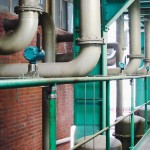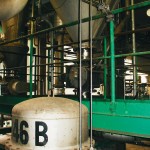Blocked filters within polyethylene pellet transportation tubes can lead to production downtime. Ineos uses wireless differential pressure transmitters to detect blocked filters at its plant in Cologne, Germany. The transmitters return the pressure data to the control system via a single gateway. With its self-organising technology, each wireless device can act as a router for other nearby devices, passing messages along until they reach their destination.
Ineos produces polyethylene, which is used for a broad range of products including pipes, packages, films and coating. Polyethylene pellets ready for customer use are transferred to the plant’s silo store through pneumatic conveying systems. Pellets are entrained in streams of air and effectively blown from one location to another. The incoming air is filtered to prevent any pollution of the final product. The filters become blocked over time and lose their efficiency, which in turn affects the end product quality. Ineos could have established a preventive maintenance routine and cleaned the filters on a time based schedule. However, this would have meant that filters were cleaned when they didn’t need it or that they could have blocked between cleans. Cleaning and unblocking the filters requires blowing to be interrupted and that is not good for the process. Should a blockage take place at the weekend, the maintenance costs are higher.
Ineos therefore chose to clean the filters on a predictive basis, doing so before they become blocked and lose too much efficiency. By closely monitoring the filter condition, the maintenance team can schedule cleaning work to take place at times that will minimise the cost and disruption caused. A liquid column (U-tube) was installed across the filter, indicating the differential pressure. An increase in pressure suggests that the filters are blocking. However, because the compressors blow discontinuously, it is not always easy to spot when a filter is blocked. In addition, manually checking and recording the results is a time consuming task that had to be undertaken daily.
Difficult-to-reach areas
Ineos explored the possibility of installing an online system that would closely monitor the condition of the filters and ensure availability. Using differential pressure meters it is possible to do this online. However, because of the location of these filters, connecting the required measurement points back to the control system using a wired solution was not feasible. The reason for this is that cabling would need to be installed in areas that are difficult to reach and the cost of a wired solution was too high. The company wanted to minimise the installation time, which made wireless an attractive option. They looked at a number of wireless technologies for this task, but found that line-of-sight solutions could not provide the reliability of connection or the robustness it required. The transmitters are positioned in a very dense working environment with many metal obstructions that can cause interference. There is also a large amount of moving equipment that could lead to temporary loss of signal with line-of-sight wireless solutions.
The search for a clear path
Ineos was confident that Emerson would be able to provide them with a robust wireless network, having worked successfully with the manufacturer on a number of other process control projects at the same site. At the end of 2007, eight Rosemount 3051S DP wireless transmitters were installed as part of a Smart Wireless network. These eight transmitters return the pres-sure data via a single Emerson 1420 gateway to the Ineos control system, where the condition of the filters can be constantly monitored. The transmitters are positioned up to 150 m from the gateway. With its self-organising technology, each wireless device can act as a router for other nearby devices, passing messages along until they reach their destination. If there is an obstruction, transmissions are simply re-routed through the network until a clear path is found to the Smart Wireless gateway. As conditions change or new obstacles are encountered in a plant, such as tempo-rary scaffolding, new equipment or a parked construction trailer, these wireless networks just reorganise and find a way to get their signals through. All of this happens automatically without any intervention by the user, providing redundant communication paths and better reliability than is possible with direct, line-of-sight communications between individual devices and a receiver. This self-organising technology optimises data reliability while minimising power consumption. It also reduces the effort and infrastructure necessary to set up a successful wireless network.
Easy to install
Ineos engineers found Smart Wireless easy to install and commission. They were wary of having to undertake a time consuming site survey for wireless installation and will consider this technology in future projects in comparison to previous installation standards. Emerson’s AMS Suite predictive maintenance software is used to manage the new Smart Wireless devices, enabling the technicians to configure them, run diagnostic checks and monitor alarms and alerts. One of the main attractions of this solution is the ease with which the network can be expanded. It is possible to add further transmitters to the existing wireless network without extra gateways. These transmitters don’t even need to have a line of sight to the gateway because the other transmitters pass the data back to the control system. The wireless network has been up and running without any problems for eight months. Ineos intends to upgrade the wireless installation shortly by introducing vibration monitoring.
Emerson Process Management
Share:








